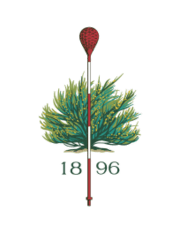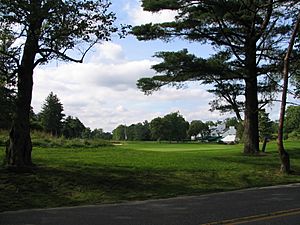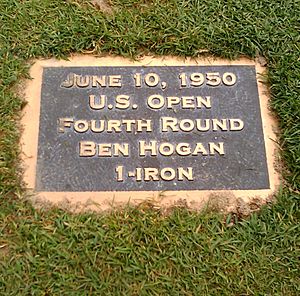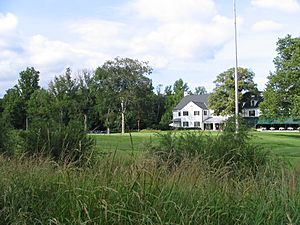Merion Golf Club facts for kids
 |
|
| Club information | |
|---|---|
| Location | Haverford Township, Pennsylvania, U.S. |
| Established | 1912 - East Course 1914 - West Course |
| Type | Private |
| Total holes | 36 |
| Tournaments hosted | |
| Website | Merion Golf Club |
| East Course | |
| Designed by | Hugh Irvine Wilson (1912) Gil Hanse & Jim Wagner (2014 renovation) |
| Par | 70 |
| Length | 6,946 yards (6,351 m) |
| Course rating | 75.1 |
| Slope rating | 151 |
| West Course | |
| Designed by | Hugh Irvine Wilson (1914) Gil Hanse & Jim Wagner (2025 renovation) |
| Par | 70 |
| Length | 5,989 yards (5,476 m) |
| Course rating | 69.9 |
| Slope rating | 122 |
|
Merion Golf Club, East and West Courses
|
|
| Location | Ardmore, Pennsylvania |
| Built | 1912 |
| Architect | Hugh Irvine Wilson |
| Architectural style | Colonial Revival |
| NRHP reference No. | 89002085 |
| Significant dates | |
| Added to NRHP | December 21, 1989 |
| Designated NHLD | April 27, 1992 |
Merion Golf Club is a famous private golf club located in Haverford Township, Delaware County, Pennsylvania. This area is right next to Philadelphia. The club has two amazing golf courses: the East Course and the West Course. The East Course is super well-known and has often been ranked among the top 10 golf courses in America by Golf Digest magazine. It has hosted many big golf tournaments, including five U.S. Opens, with the most recent one in 2013.
History of Merion Golf Club
How Merion Golf Club Started
The Merion Golf Club began in 1896. It was started by members of the Merion Cricket Club, which was founded much earlier in 1865. They opened their first golf course in Haverford Township, Pennsylvania. The land where the East Course is now was once a farm bought in 1744, and the old farmhouse is now the club's clubhouse!
Building the New Courses
In 1910, the club decided to build a brand new course. They chose a talented club member named Hugh Irvine Wilson to design it. He was 32 years old, a graduate of Princeton University, and a great golfer. The Merion East Course opened in September 1912. Then, the West Course, also designed by Wilson, opened in May 1914. The golf club officially became separate from the Merion Cricket Club in 1941.
Hugh Wilson's Smart Design
Hugh Wilson had never designed a golf course before. So, he took a seven-month trip to Scotland and England to study famous British courses. He brought back many ideas for Merion East. One cool feature is Merion's unique Scottish-style bunkers, which are now called the "white faces of Merion." These bunkers are like sandy traps that challenge golfers.
Wilson's design for the East Course covers only about 126 acres, which is quite small for a golf course. Despite its size, it's considered one of the best. In 2015, it was ranked fifth in Golf Digest's "America's 100 Greatest Golf Courses." Even famous golfer Jack Nicklaus said Merion East might be "the best test of golf in the world" for its size. The club was recognized as a National Historic Landmark in 1992 because of Wilson's new ideas in golf course design.
Merion's Many Tournaments
Merion has hosted 18 championship tournaments for the United States Golf Association (USGA), which is more than any other course! The very first two, the 1904 and 1909 U.S. Women's Amateurs, were held at the original Haverford course. The first men's tournament on the East Course was the 1916 U.S. Amateur. That's where Bobby Jones first played in a national championship when he was just 14 years old!
Bobby Jones Achieves the Grand Slam
In 1930, the U.S. Amateur tournament returned to Merion. Earlier that year, Bobby Jones had already won three major golf championships. Everyone was excited to see if he could win all four major championships of that time, which was called the "impregnable quadrilateral."
Jones played incredibly well and reached the final match against Eugene Homans. A huge crowd of 18,000 people came to watch! Jones won the match easily. An Atlanta news reporter, O. B. Keeler, called this amazing achievement the "Grand Slam," a term still used today. Just seven weeks after this historic win, Bobby Jones retired from competitive golf at age 28.
Ben Hogan's Amazing Comeback
The 1950 U.S. Open at Merion was the site of an incredible comeback by golfer Ben Hogan. Just 16 months before, Hogan had been in a terrible car accident that almost killed him and shattered his pelvis. He was still in pain during the tournament.
On the final hole, Hogan needed a par to force a playoff. He hit an amazing shot with a 1-iron from over 200 yards away, landing it perfectly on the green. He then made two putts for par. Hogan went on to win the tournament in an 18-hole playoff! A famous photo of Hogan's 1-iron shot is one of the most well-known pictures in golf history. There's even a plaque on the 18th fairway at Merion to remember this famous shot.
Lee Trevino Beats Jack Nicklaus
The 1971 U.S. Open at Merion also ended in a playoff. This time, it was between two of the best golfers in the world: Jack Nicklaus and Lee Trevino. Both players missed putts on the last hole that could have won them the tournament. In the playoff, Trevino played better and won by three strokes, earning his second U.S. Open title.
Merion's Course Gets Stronger
After the 1981 U.S. Open, some people thought Merion might not host major tournaments again. The course was considered a bit short, and there wasn't much space for large crowds or event tents. However, Merion acquired some nearby land and made the East Course longer, almost 7,000 yards! These changes helped address the concerns.
After successfully hosting the U.S. Amateur in 2005, the USGA decided to bring the U.S. Open back to Merion in 2013. This was 32 years after its last U.S. Open. Justin Rose won his first major championship there. Many players praised the course, saying it was a great test of golf, even with worries that modern players might score too low.
The Wicker Baskets of Merion
On Merion's East Course, you won't see regular flags on top of the pins. Instead, all the pins have unique wicker baskets! (The West Course uses normal flags).
One story says that when Hugh Wilson was studying golf courses in England, he saw sheep herders using staffs with wicker baskets on top. They kept their lunch in these baskets to protect it from animals. Wilson supposedly got the idea to use them at Merion. The baskets are helpful because you can see them even if there's no wind, but they don't tell golfers which way the wind is blowing. They have been used since at least 1916 and are even part of the club's logo.
These pin markers are also a bit different from standard ones. They are about 7 feet, 6 inches tall, including the 14-inch high baskets, making them 6 inches taller than regular flagsticks. The poles are solid metal, not fiberglass. The baskets are red on the first nine holes and orange on the second nine. Interestingly, the 1950 U.S. Open was the only USGA championship at Merion East where flags were used instead of baskets.
Until around 1980, a member of the grounds crew made the wicker baskets by hand. Now, a special woman in South Carolina, whose identity is kept secret, makes them. Anyone who wins a USGA event at Merion gets a wicker basket top as a prize! The golf course staff collects the baskets every night to make sure they are safe and not stolen.
Tournaments at Merion
Major Championships Hosted
| Year | Tournament | Winner | Winner's share ($) |
|---|---|---|---|
| 1934 | U.S. Open | 1,000 | |
| 1950 | U.S. Open | 4,000 | |
| 1971 | U.S. Open | 30,000 | |
| 1981 | U.S. Open | 55,000 | |
| 2013 | U.S. Open (5) | 1,440,000 | |
| 2030 | U.S. Open | ||
| 2034 | U.S. Women's Open | ||
| 2040 | U.S. Open | ||
| 2046 | U.S. Women's Open | ||
| 2050 | U.S. Open | ||
- ^ 18 hole playoffs: 1950, 1971
Amateur Championships Hosted
| Year | Tournament | Winner |
|---|---|---|
| 1904 | U.S. Women's Amateur | |
| 1909 | U.S. Women's Amateur | |
| 1916 | U.S. Amateur | |
| 1924 | U.S. Amateur | |
| 1926 | U.S. Women's Amateur | |
| 1930 | U.S. Amateur | |
| 1949 | U.S. Women's Amateur (4) | |
| 1966 | U.S. Amateur | |
| 1989 | U.S. Amateur | |
| 1998 | U.S. Girls' Junior | |
| 2005 | U.S. Amateur (6) | |
| 2026 | U.S. Amateur |
- The East Course opened in 1912 and was first used for the 1916 U.S. Amateur.
International Team Competitions Hosted
| Year | Tournament | Winner |
|---|---|---|
| 1954 | Curtis Cup | |
| 1960 | Eisenhower Trophy | |
| 2009 | Walker Cup | |
| 2022 | Curtis Cup (2) |






